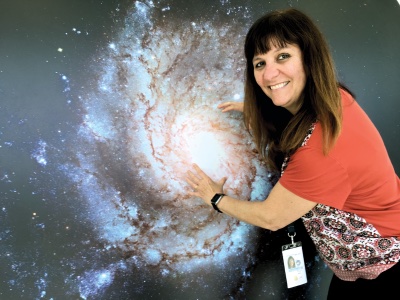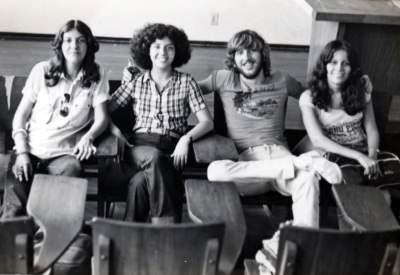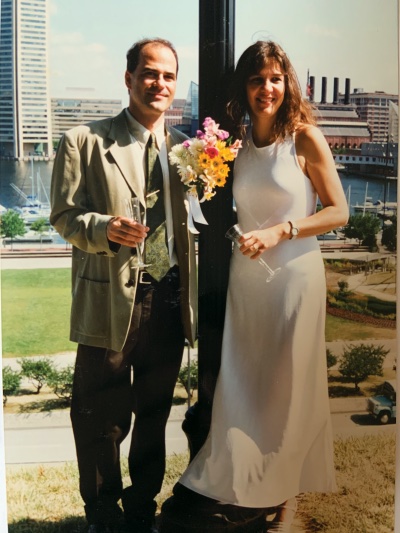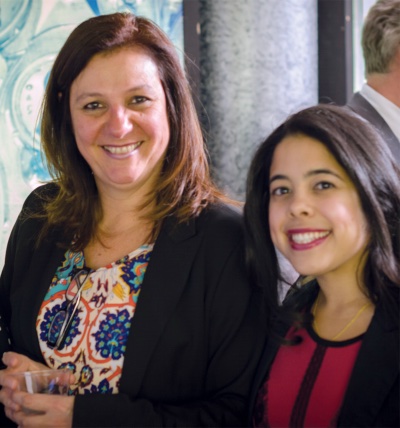

By Katie Bahr
CatholicU, Fall 2021
After years spent making discoveries about our universe, astrophysicist and Vice Provost Duilia de Mello is working to help young people reach for the stars.
Duilia de Mello has a passion for the stars. As an astrophysicist, she has traveled the world researching galaxies — including how they evolve and interact. She has made incredible discoveries like the supernova SN1997D, stellar nurseries known as blue blobs, and the largest spiral galaxy in the universe.
At Catholic University, she serves as a professor and vice provost for global strategies and she is charged with raising the University’s international reputation as a research institution. In her home country of Brazil, however, de Mello’s own reputation looms large — she is a well-regarded children’s author and a sought-after public speaker who has spoken about space in front of stadium-sized audiences. One Brazilian brewery, Scientia Beer, even named a white IPA in her honor.
In 2013, de Mello was honored with a Professional of the Year Award of the Brazil Diaspora given by the Ministry of Foreign Affairs, and a year later she was chosen by Barnard College as one of the “10 Women Changing Brazil.” In 2017, she was named by Universo Online as one of “17 Women Who Made a Difference in 2017.” And last year, de Mello was awarded the Order of Rio Branco, one of the highest honors bestowed by the Brazilian government.
For de Mello, all of these accomplishments are but a consequence of a lifelong quest to satisfy her own curiosity. She learned the importance of education when she was just a young girl. Now, she works to share her wisdom and love of science with young people.
As part of her work, de Mello says she looks for “the Duilias in the audiences” and tries to encourage them to get excited about space and follow their dreams.
“If astronomy is what they want to do, I tell them they can do it,” she says. “But the overall goal is just to bring curiosity and awareness into their lives, to teach them the importance of science, and reinforce that women can do whatever they want to do.”

De Mello poses with an image of a spiral galaxy.
The youngest of four children, de Mello grew up in Rio de Janeiro, in a family where education was highly valued. Her mother was a former elementary school teacher who always stressed the importance of curiosity and intellectual independence.
“She told me that higher education has this power of lifting your life and she wanted her daughters to be independent of their husbands,” de Mello says. “She was very serious about that and my sister and I took it seriously too.”
From a young age, de Mello enjoyed nature and gazing up at the night sky.
‘The full moons in the summer in Rio were just amazing,” she says. “I always wondered about the universe and wanted to know more and more.”
De Mello loved all things related to space, including science fiction like “Star Trek” and “Star Wars” and the TV show “Cosmos.” She was fascinated by the early images of planets being transmitted by the NASA spacecrafts Pioneer 11 and Voyager 2 and she saw the universe as a fascinating mystery to solve.
“I had so many questions about space,” she says. “I thought, if I became an astronomer, I would know all the answers.”

De Mello’s parents worked hard to give their children the best education they could provide. They sought out scholarships for Catholic schools and private schools and researched free public options and grants for higher education. When it came time for de Mello to go to college, she enrolled in the astronomy program at the Federal University of Rio de Janeiro. The experience was intense. Though she had always been good at math and science, she had trouble adjusting to the rigorous physics coursework. She also spent much of her time traveling back and forth between her classes on the main university campus and the observatory, which was in a different location.
Still, the more she learned about space, the more she wanted to know. Propelled by her love of technology and telescopes, de Mello continued her studies to earn a master’s in radioastronomy at the National Institute for Space Research in Brazil in 1988, and another master’s degree from the University of Alabama in physics and astronomy in 1993. She then studied at the University of São Paulo, where she earned her doctorate in 1995. Her thesis included her research on the interactions between pairs of galaxies, and mixed pairs of galaxies.
Along the way, de Mello was always looking for her next opportunity to learn and grow. When the director of an observatory in Chile came to the University of São Paulo to give a lecture, she approached him and asked about fellowship opportunities. That conversation led to her postdoctoral fellowship at the Cerro Tololo Inter-American Observatory in Northern Chile and later at the National Observatory in Rio de Janeiro.
As part of that fellowship, de Mello worked at the ESO 1.5m telescope in la Silla, Chile. One night in January of 1997, she was observing by herself when she noticed something unusual.
“I was collecting the data, which is like taking a photograph, but letting the camera stay open for a long time,” she says. “The computer will collect the light while you’re waiting for the computer to finish the image. Once I got the visual, it was very different from what I had expected.”
When she first saw the image, she thought it was an extra star in another galaxy, but then she realized that would mean it was 56 million light years away and too faint to see. Tommy Wiklind, an astrophysicist who now works as a Catholic University research professor, was also observing in Chile at that time. He had just finished a 12-hour shift and stopped by to bring de Mello a sandwich.
“I told him, ‘I think I discovered a supernova,’” de Mello remembers.
It took another 24 hours, a visit to the library, and verification from an expert to confirm that she was the one who had discovered the exploding star. The discovery made front-page news in Brazil and was a reminder for de Mello of why she had wanted to study astronomy in the first place.
“I always loved the importance of supernovas for us, and for life,” she says. “It is when a star explodes that it actually pollutes the universe with other elements that become new life."
In a similar way, de Mello’s discovery breathed renewed life into her career. After years spent going through the grind of graduate school, she had begun to lose the joy that had brought her into the field.
“You can sometimes end up forgetting why you became a scientist and why you’re doing it,” she says. “The supernova kind of brought the feelings back, all the emotions and dreams and the questions and curiosity I had since I was a kid.”
A few months after discovering the supernova SN1997D, de Mello accepted a prestigious position that would change her life: a postdoctoral fellowship working at the Hubble Space Telescope Science Institute in Baltimore, Md.
During her time in the institute, de Mello worked 18-hour days with postdocs from around the world to study the Hubble Deep Field South, an image taken by Hubble that revealed thousands of previously unseen galaxies. She also helped to develop Starburst99, a web-based software designed to model spectrophotometric and related properties of star-forming galaxies.

It was a fruitful time in de Mello’s personal life as well. She and Wiklind got engaged in the airport before Duilia moved to the U.S., buying their rings at an airport jewelry store. They were married in the summer of 1997 with her boss at the Hubble Space Institute, Claus Leitherer, as their witness.
Next came the opportunity to live with Wiklind in Sweden. De Mello accepted a fellowship teaching at Chalmers University of Technology in Gothenburg. The couple stayed for three years, before de Mello was able to use her connections to find a new position at the NASA Goddard Space Flight Center in Greenbelt, Md., working on another Hubble project. Her position as a contractor was funded through Catholic University’s Institute for Astrophysics and Computational Sciences.
At Goddard, de Mello continued to study interacting galaxies both near and far from Earth, trying to understand how galaxies and stars evolve. In 2008, she made news by using Hubble images to identify what her team nicknamed “blue blobs” — clusters of mostly young stars 12 million lightyears away.
That same year, she taught her first course at Catholic University, Physics for Architects, which led to her joining the physics department as a tenure-track professor. She started teaching an astronomy class for non-scientists, the popular Physics 103, which she taught for 10 years. De Mello, who says she has always had a knack for explaining scientific concepts to people who are unfamiliar with the topic, loved being in the classroom and passing on her passion to others. In 2016, she became the first woman to be promoted to an ordinary professor in the department.
Emmaris (Amy) Soto, Ph.D. 2017, first met de Mello when she worked as her teaching assistant in 2012. She says de Mello was instrumental in helping her find a summer internship at NASA Goddard and exposing her to different topics in astrophysics to study. To this day, they still work together on the ultraviolet team for the CANDELS (Cosmic Assembly Near-infrared Deep Extragalactic Legacy Survey) project. As part of that research, they have been collecting data from around seven billion years ago to learn about galaxy and star formation.
“She has been the most outstanding mentor I could ever have, in terms of providing educational support, finding opportunities for me, pushing me to succeed, and having goals and expectations for me,” Soto says. “I’m very grateful that she is my mentor and friend.”
Soto remembers how de Mello would throw star parties for her students, setting up a telescope between Hannan Hall and the Pryz so they could observe the skies for themselves.

“She’s good at explaining things and she’s very passionate,” Soto said. “Her thought is, even if students don’t become scientists, if we can convey to people why this subject is important, in the future, they will support this kind of work.”
Soto also admires the way de Mello pays attention to her students’ experiences and can see how some have had more opportunities than others.
“Duilia’s mindset is always that, ‘We can do more,’” Soto says. “She listens to her students, sees problems — sometimes ones that others don’t recognize — and she looks for solutions."
Eventually, it was that drive to do more for her students that inspired de Mello to step into an administrative role, first as a vice provost for research support and dean of assessment and then in her current role as vice provost for global strategies.

One of the big initiatives in her first year was working on a team to promote the University’s research identity through the development of University Research Day, which has since become a University tradition.
As part of her work in the provost’s office, de Mello was also placed in charge of overseeing the University’s library system. She was asked to pay particular attention to the Oliveira Lima Library, a collection dedicated to the history and culture of Portugal and Brazil that had been closed to the public for a couple of years before reopening in 2018. The original collection of 40,000 volumes was the personal library of the Brazilian diplomat, historian, and journalist Manoel de Oliveira Lima, who died in 1928.
De Mello, who was charged with reopening the library and raising its profile, said she feels connected to the collection because it tells the history of Portuguese people all over the world. She also has grown to feel an affinity with Oliveira Lima and his wife, Flora.
“They were collectors and I myself am a collector,” she says. “Seeing what they collected brings me closer to them in a way. They were very interesting for their time, they were travelers, they were explorers, they were curious, they were the influencers of their time.”
Though she never would have imagined herself being put in charge of
a collection like the Oliveira Lima Library, de Mello feels it is just another adventure on her career path.
“I always tell my students, when they get really anxious about their future, you never know what’s going to happen,” she says. “You have to sometimes be prepared for some turns.”
Years into her career, de Mello now finds fulfillment in encouraging young people to follow in her footsteps. She has written two books for young readers, Vivendo com as estrelas (Living with the Stars) and The Adventures of Pedro, a Space Rock. In the former, de Mello recounts her trajectory to studying astronomy and gives advice for young people on how to enter the field.
“I talk about how you don’t have to be a genius to be an astronomer,” de Mello says. “I also explain the scientific method and what it means to discover something.”
The book turned out to be successful in a way de Mello could not have anticipated, turning her into a celebrity for Brazilian young people interested in space.
“I constantly receive messages from people saying, ‘I did this because you inspired me to do it.’ It’s very touching to have that kind of influence on people’s lives,” she says. “Someone once told me that, ‘Talking to you is like talking to Batman.’ I’ve been called Batman! Think of the implications of that — me being compared to this male superhero. Incredible, right?”
De Mello founded her nonprofit Mulher das Estrelas (Woman of the Stars) and began speaking at events across Brazil to inspire young people to enter the sciences. Since her organization began to take off in 2016, de Mello says she has spoken to more than 40,000 students. Her most recent in-person event in Brazil took place before the pandemic and included 6,000 high school students. In 2018, she says, she traveled to Brazil seven times for weekends filled with speaking engagements.
Livia Lopes works closely with de Mello as the associate director of both the Vice Provost Office of Global Strategies and Catholic University’s Institute for Latin American and Iberian Studies. She finds a lot of inspiration in the work de Mello does.
“If it’s an activity aimed at encouraging girls to study science or STEM, she will be there,” Lopez says.
Although Lopes is a lawyer by education, she shares many similarities with de Mello. Both grew up in Rio and studied in a public university in Brazil before moving to the U.S. to pursue their careers. Lopes believes de Mello is a good role model for other Hispanic or Latin American researchers trying to pursue careers in any field.
“Everyone sees, yes, she’s competent, she’s talented, she’s notable. We
have a lot of other people in minority groups who are as competent, talented, and resilient as her,” Lopes says. “This opens doors for others to come after her.”
Wiklind also admires the work his wife does to help inspire others.

“She has a passion for connecting with people and letting others sort of take part in her achievements,” he says. “She’s using her career to inspire young people under sometimes very dire circumstances to actually move forward and be able to fulfill their dreams.”
When she speaks to young people, de Mello always tells them to pursue their goals, but to remember that goals can sometimes change.
“I tell them what a scientist does and teach them what it’s like to be a professor. And I tell them to really follow their dreams,” she says. “Dreams are not letting other people tell you what you should be doing.”
Throughout the pandemic, de Mello has brought her advocacy online, scheduling virtual presentations and meet-ups to talk to young girls about the possibilities in their lives. In June, de Mello gave one Zoom presentation for 1,500 participants. Soon after that, she had a memorable talk over Instagram Live with three young girls — one of whom was an eight-year-old amateur astronomer.
“That’s one of the nicest ones I’ve done,” de Mello says. “It was incredible to see their eyes shining and bright, and to give them a little bit of hope.”